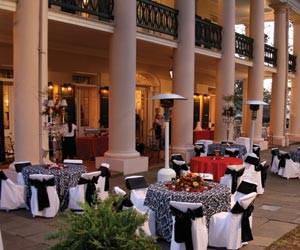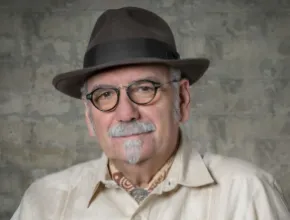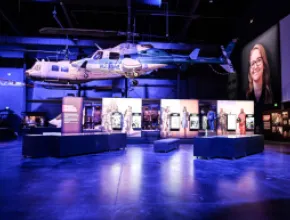In a city blessed with superlatives, whittling down the vast and varied experiences of the "Big Easy" is a challenge. New Orleans is one of the most culturally diverse cities in the world, not to mention one of the most magnetic. Following is a small sampling of the most distinctive experiences the destination can offer groups.
1. Mardi Gras World
Mardi Gras is as synonymous with New Orleans as Mickey Mouse is with Disney World.
The center of all things Mardi Gras is at Mardi Gras World, where elaborate floats are conceived and brought to life.
"When I started in Mardi Gras it was a $100,000 a year industry. I personally helped grow it into a billion-dollar industry," says 83-year-old Mardi Gras World Owner Blaine Kern, nicknamed "Mr. Mardi Gras." "I’ve been doing this for 74 years."
Visitors are introduced to the facility with a movie comparing old Mardi Gras and the Mardi Gras of today. The movie is followed by a tour of The Float Den, another name for the sprawling warehouse filled with floats of the past and providing space for artists to work on new floats.
"They watch a film and then watch sculptors building and painting the props," Kern says.
Groups can get picked up from their hotel in a float and escorted to The Float Den for a reception or theme party. Another option is to participate in mask-making and float-decorating competitions as team-building efforts.
Also at the complex, the Grand Oak Plantation is a faux antebellum home set up with 40-foot-tall Corinthian columns, a lagoon, life-size oak trees draped with Spanish moss and a large theater for entertainment, which is very flexible as far as decorating, according to Kern.
"Whatever the customer wants—ancient Mexico, ancient Greece—within 24 hours we can transform the theater into anywhere on or off planet Earth," Kern says.
Insider Insights: New Orleans
The complex also includes the River City Ballroom for more intimate affairs and River City Plaza. Groups of 10,000 or more can host events.
2. National World War II Museum
Matching Mardi Gras World for versatility, the National World War II Museum is one of the city’s main attractions and a favorite with groups. The museum itself tells the story of America’s participation in the war, including multimedia exhibits and a 4-D Tom Hanks- narrated film, Beyond All Boundaries, shown in the Solomon Victory Theatre across the street from the museum. The main area for groups is the Louisiana Memorial Pavilion, with its hanging C-47 plane overhead.
"The National World War II Museum is such a unique venue. Where else can your guests dine and dance under a C-47 or have cocktails surrounded by the stars of the war era?" says Michelle Mueller, the museum’s director of sales.
Also part of the complex is the Stage Door Canteen, which hosts performances by the Victory Belles, a trio recalling the World War II era of music. Groups can hire the Victory Belles for functions.
"The Victory Belles add the perfect mix of glamour and patriotism that defined entertainment in the World War II era," says Victoria Reed, manager of entertainment programs for the venue. "We can pair them up with our own swing band, the Victory Six, or they can perform anything from the National Anthem to an Andrews Sisters-style revue to entertain guests."
Attached to the theater, renowned chef John Besh’s group-friendly American Sector restaurant serves overflowing plates of World War II-era comfort foods as well as an assortment of other flavors, from crabmeat pies to pork cheeks.
The museum will be expanding with four new buildings through 2014. Slated to debut next year will be the Restoration Pavilion, where visitors will be able to see the techniques used to repair and restore World War II-era vehicles, military equipment and other artifacts. The last to open will be the Liberation Pavilion, with exhibits spanning the closing months of the war and immediate postwar years.
3 Contemporary Arts Center
In close proximity to the National World War II museum and the Ernest N. Morial Convention Center, the Contemporary Arts Center (CAC) focuses on local artists in its rotating exhibits. The 100-year-old space is now an open four-story atrium and gallery, which also houses a 200-seat theater used for dance and other performances or presentations.
"We’re five blocks from the convention center. Our location is ideal," says Shelley Middleberg, director of sales and hospitality management for the CAC.
The key is the number of ways groups can use the space, including several rooms that can be used as meeting venues.
"One thing we have that’s a leg up on other venues is a lot of resources for creative decor; we work with every living and breathing artist in town," says Lindsay Ross, director of communications for the CAC.
One option for groups is to use the CAC’s attached warehouse, with 18,000 square feet of raw space, sans artwork. Groups can bring in muralists, video artists or sculptors to decorate its blank walls. Groups can also have cocktails in the main building’s galleries and then walk to the warehouse for dinner. The center can bring in DJs and other entertainment.
There is even the option to close off the surrounding street as it did for a Starbucks conference in 2008.
"We were selected to host the closing reception, which was a street party," Middleberg recalls. "We closed four blocks for 10,000 people—it was very exciting and very successful."
4. Oak Alley Plantation
For a taste of Southern elegance, Oak Alley Plantation is one of many plantation homes open to groups. Located on the Mississippi River less than an hour from New Orleans, the plantation is nicknamed "Grande Dame of the Great River Road." A quarter-mile canopy of giant oak trees, believed to be nearly 300 years old, leads to the Greek Revival-style antebellum home.
"We can do just about anything depending on the budget," says Debra Mayhew, marketing director for Oak Alley Plantation. "A lot of times the bus drops groups off in front of the alley and we have mint juleps waiting as they get off and walk down the alley to the mansion. In the top gallery outdoors we can have a gospel choir greeting them or a Cajun band."
Oak Alley can also organize Civil War reenactments for groups or theme parties with staff and guests in 1830s antebellum-style dress.
The plantation is open for tours during the day and can be reserved in the evening for private tours and a dinner, with a capacity inside the house for 30 for a sit-down dinner and 250 outside. There is also a building in the back of the plantation home, a former blacksmith shop, which can accommodate groups for dinners.
"It’s rustic with wood and exposed beams, but it can be dressed up, too," Mayhew says.
A popular option is a cocktail reception in the mansion and dinner in the less formal, larger building.
5. Mansions/Historic Homes
Groups don’t need to go farther than the French Quarter or Garden District to experience the city’s grand historic homes.
The elegant Garden District features a number of mansions available to groups, including the Van Benthuysen-Elms Mansion, a blend of Italianate and Greek Revival design. Built in 1869 for industrialist Watson Van Benthuysen, the house later served as the German consulate as well as the residence of John "TAC" Elms. Today the home is operated as a special events venue by the third generation of the Elms family.
"When people have their functions here, we’ll hear all the time as they are exiting, ‘This is really New Orleans.’ It’s such a compliment to us," says Faith Roche, one of the owners of the mansion, which in 1950 was purchased by her grandfather.
The mansion encompasses a garden-lined city block and is on the famous St. Charles streetcar line. Groups can rent a streetcar to the mansion, which can host functions of up to 500. The staff can arrange entertainment, from caricature artists to fortune tellers as well as organize voodoo theme parties replete with snake charmers.
In the French Quarter, the 1831-era Hermann-Grima House (www.hgghh.org) is one of the most significant residences in New Orleans. The Federal mansion and its courtyard garden boasts the only intact horse stable and functional 1830s outdoor kitchen in the French Quarter.
Throughout the house, visitors explore furnishings and accessories typical of an elegant French Quarter residence. Visitors can tour the original stables, the outdoor kitchen with the open hearth for cooking and the restored courtyard, which is available for special events of up to 250.
6. Southern Food & Beverage Museum
Food is as much a part of New Orleans’ culture as music and Mardi Gras, and the Southern Food & Beverage Museum pays homage to the rich history behind the local cuisine, from po’ boys to jambalaya. The Museum of the American Cocktail also resides in the facility, which is located in the Riverwalk Marketplace next to the Hilton New Orleans Riverside.
"It’s a great place to get the history of the city all through the lens of food," says Liz Marshall, president and director of the museum, which opened last year.
A centerpiece of the museum is the historic bar from the former Brunings Restaurant, which was the third-oldest restaurant in New Orleans until it was flooded during Hurricane Katrina. The restaurant, which was located on Lake Pontchartrain, never reopened, but the 1852-era bar was saved.
"It was in 176 pieces when we got it," Marshall says. "It took a few months to get a photograph of it at the right angle and once we got the photographs our restorer took three days to put it back together."
The bar area is a central spot for group receptions. The museum can also organize a number of programs, such as bringing in chefs and mixologists for demonstrations.
"We have some people who are actually cocktail historians and they have a wonderful way of telling how to make the drink and telling all of the history—how it developed and how it was drunk and the right drinking paraphernalia," Marshall says. "People get to sample the drinks."
Food theme parties are popular, such as a gumbo party with four kinds of gumbo stations. The museum has even hired oyster shuckers for events. There is easily space for 500 for receptions.
7. BBC Destination Management
A number of DMCs can help groups tap into New Orleans’ unique flavor, including BBC Destination Management, which offers a full range of creative tours and activities.
To dig into the city’s culinary outlets, BBC organizes an outing to the House on Bayou Road, an antebellum home where groups can learn the secrets of New Orleans cuisine as well as how to cook authentic New Orleans food.
"Guests leisurely rotate among two chefs demonstrating a single course," says Bonnie Boyd, president and CEO of BBC. "Famous New Orleans appetizers and desserts are presented for guests to enjoy at their leisure."
Another participatory option is a jam session with Charmaine Neville of New Orleans’ famous Neville family. Sessions are held at Tipitina’s, one of the first among the Crescent City’s clubs to foster and nurture the native music of New Orleans, according to Boyd. Neville records all of the songs that come out of the session, and the CDs are sent to each guest.
Groups can also organize private tours such as the Spirits and Spirits Tour, which visits sites of documented hauntings and follows with a cocktail-making demonstration.
At one of the city’s oldest restaurants, Tujague’s, groups learn how to make a Sazerac and Pimm’s Cup cocktail as well as try a sample of each. The next stop is at the oldest bar in the country, Jean Lafitte’s Blacksmith Shop, for a nightcap.
8. Historic New Orleans Tours
If any city is ripe for a walking tour, New Orleans is it. The only dilemma is choosing which, with options that range from voodoo tours to plantation tours. Historic New Orleans Tours covers the gamut and can accommodate groups of any size.
"We can arrange group tours for everything we offer and subjects that aren’t on our schedule," says owner Robert Florence. "There is no maximum number of people we can accommodate because we can always bring in however many guides we need."
According to Florence, the most popular walking tours for groups are the cemetery and French Quarter tours, while the most requested driving tours are the city tours and tours of Hurricane Katrina recovery sites.
The company has introduced new options this year, including a jazz music tour that starts with the history of the Preservation Hall and hits several local spots, including Congo Square, historic site of slave gatherings, where pure West African religious rituals and musical traditions were performed. Congo Square is considered the birthplace of all New Orleans music. There is another stop at J&M Music, where the likes of Fats Domino and Little Richard recorded, though its current incarnation is a laundromat with historic photos on the walls.
Historic New Orleans offers intriguing haunted tours of the city’s spookiest sites and tales of the ghosts that lie within, as well as swamp tours, Garden District tours and cocktail tours.
9. Voluntourism
One of the most rewarding options for groups is to arrange an afternoon volunteering for one of the many organizations still putting back the pieces post-Hurricane Katrina.
"We are fortunate to have a public relations department that works closely with many agencies in the area," says Nikki Nicholson, vice president of sales for the New Orleans Metropolitan CVB. "They match the agency with the association or corporation based on the needs of the group. It is an excellent opportunity for team building."
The New Orleans Area Habitat for Humanity builds homes in many communities that were decimated. Most notable is Musician’s Village in the Upper Ninth Ward, conceived by New Orleans natives Harry Connick Jr. and Branford Marsalis, and focusing on housing musicians and artists displaced by the storm. Groups must comprise 15 people and can be as large as hundreds.
Beacon of Hope founded its Beacon of Hope Resource Center in the Lakewood neighborhood and is a grassroots organization helping rebuild hard-hit neighborhoods, including the Lakeview, Gentilly and Lower Ninth Ward. Volunteers assist homeowners with tasks such as landscaping, laying sod, painting, hanging drywall, gutting and other improvements. Volunteer groups of any size are welcome with at least a month’s advance notice, and no skills are required.
Catholic Charities is a multifaceted group that serves a variety of organizations and needs, including response and recovery, housing, healthcare and education. Volunteer opportunities range from half-day activities to two-day options, from assisting at the Second Harvest Food Bank to helping repaint and repair a person’s home damaged from Katrina.
10. Mid City Lanes Rock ’n’ Bowl
For true local flavor, Mid City Lanes Rock ’n’ Bowl is a New Orleans institution.
Formerly located in one of the major Hurricane Katrina flood zones, the Rock ’n’ Bowl moved just over a year ago closer to the Uptown district, about a mile from the St. Charles streetcar line.
"We were located upstairs in the old place," says owner John Blancher. "There was seven feet of water—everyone around me was decimated. But we were able to get back up—the first business up for miles and miles. The first night we opened we had the neon bowling pin on but there was not a traffic light to be seen."
The current location was an old warehouse and is located next door to Blancher’s Ye Olde College Inn restaurant, which has been in operation since 1933.
Rock ’n’ Bowl, which can host 1,000, is known for its live music, including weekly music nights such as Tuesday for New Orleans R&B, Wednesday for swing and Thursday for zydeco. Blancher can hire musicians for private functions.
"From the lanes you can see the band onstage," Blancher explains. "Bowling is always accessible."
Groups looking for a catered affair can organize food from next door, featuring everything from pizza to New Orleans fare such as catfish and shrimp remoulade.







